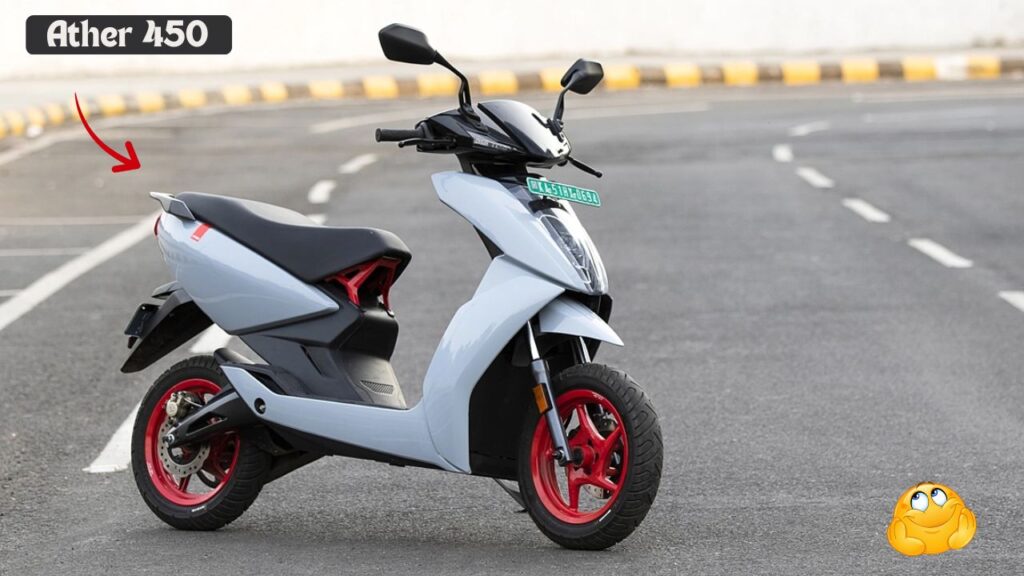Ather 450 Electric Scooter : Ather Energy, a pioneer in the Indian electric scooter market, is set to launch its highly anticipated 2025 Ather 450 Electric Scooter on January 4. With upgraded features, improved performance, and enhanced technology, the new Ather 450 aims to deliver an even better urban commuting experience.
In this article, we take an in-depth look at the key features, performance, design, and why the 2025 Ather 450 is a game-changer in the electric scooter segment.
Efficient and Powerful Electric Motor
The 2025 Ather 450 is powered by a 5.4 kW electric motor, delivering a peak torque of 26 Nm, ensuring smooth acceleration and effortless performance in urban traffic.
This motor allows the scooter to reach a top speed of 80 km/h, making it well-suited for city commutes and short highway rides.
The scooter features a 3.9 kWh lithium-ion battery pack, providing a real-world range of up to 120 km on a single charge in Eco mode.
With improved thermal management and efficiency, the 2025 model ensures better performance and reliability under varying conditions.
The Ather 450 supports fast charging, allowing riders to charge up to 60% in just 45 minutes with Ather’s fast chargers.
For home charging, the scooter can achieve a full charge in approximately 5 hours using the standard charger.
Sleek and Futuristic Design
The Ather 450 retains its signature sporty and aerodynamic design while incorporating subtle updates for a refreshed look.
The scooter features a LED headlamp setup with integrated DRLs, giving it a sleek and modern appearance.
The compact body and sharp lines enhance the scooter’s agility and aesthetics, while the lightweight frame ensures easy handling.
Available in vibrant colors like Cosmic Black, Lunar White, and Neon Green, the 2025 Ather 450 caters to a variety of style preferences.
The spacious floorboard and ergonomic seat design provide a comfortable ride for both the rider and pillion, making it a practical choice for daily commutes.
Advanced Technology and Features
The 2025 Ather 450 is packed with advanced features, making it one of the most tech-savvy scooters on the market.
The scooter includes a 7-inch touchscreen dashboard, offering real-time information like speed, range, battery status, and navigation.
With Ather Connect, riders can access features like remote tracking, ride statistics, and geofencing via a smartphone app.
The scooter also supports over-the-air (OTA) updates, ensuring that users always have access to the latest software and features.
Keyless ignition, reverse assist, and smart alerts for low battery or maintenance needs add to the scooter’s convenience.
The Ather 450 also comes with multiple ride modes, including Eco, Ride, and Sport, allowing riders to choose between efficiency and performance based on their needs.
Enhanced Safety Features
Safety is a top priority for Ather Energy, and the 2025 Ather 450 includes a range of features to ensure a secure ride.
The scooter is equipped with CBS (Combi Braking System), ensuring effective and balanced braking.
The tubeless tires provide better grip on various road conditions, while the rear mono-shock suspension and telescopic front forks ensure a smooth and stable ride over bumps and potholes.
With a sturdy frame and a ground clearance of 165 mm, the Ather 450 is built to handle challenging urban terrains with ease.
Cost-Effective and Eco-Friendly
The 2025 Ather 450 is not just a premium scooter but also a cost-effective and environmentally friendly alternative to petrol-powered vehicles.
With an estimated running cost of ₹0.30 per km, the scooter offers significant savings on fuel expenses.
Its zero-emission electric powertrain contributes to reducing pollution, making it an ideal choice for eco-conscious riders.
Pricing and Availability
The 2025 Ather 450 is expected to be priced competitively, starting at ₹1.39 lakh (ex-showroom).
Pre-bookings for the scooter will commence soon after the official launch on January 4, with deliveries expected to begin by mid-January 2025.
The scooter will initially be available in major cities through Ather’s extensive network of experience centers and showrooms.
Why Choose the 2025 Ather 450
The 2025 Ather 450 stands out as a feature-rich, powerful, and efficient electric scooter that caters to the needs of urban commuters.
Its advanced technology, improved range, and sleek design make it an excellent choice for those looking to transition to electric mobility.
With Ather Energy’s trusted legacy, robust build quality, and growing charging infrastructure, the 450 ensures a hassle-free ownership experience.
Conclusion
The 2025 Ather 450 Electric Scooter is a perfect blend of style, performance, and sustainability.
With its impressive range, advanced features, and competitive pricing, it offers a premium yet practical solution for modern urban commuting.
If you’re looking for an electric scooter that delivers on performance, technology, and eco-friendliness, the 2025 Ather 450 is a standout choice.
Mark your calendar for January 4, 2025, and be ready to embrace the future of electric mobility with the Ather 450.
Also Read This –
OnePlus Foldable Phone Big Processor, Big Battery, Big Buzz
Hero HF Deluxe Own It at ₹15K with Smart Tech & Remote Start


